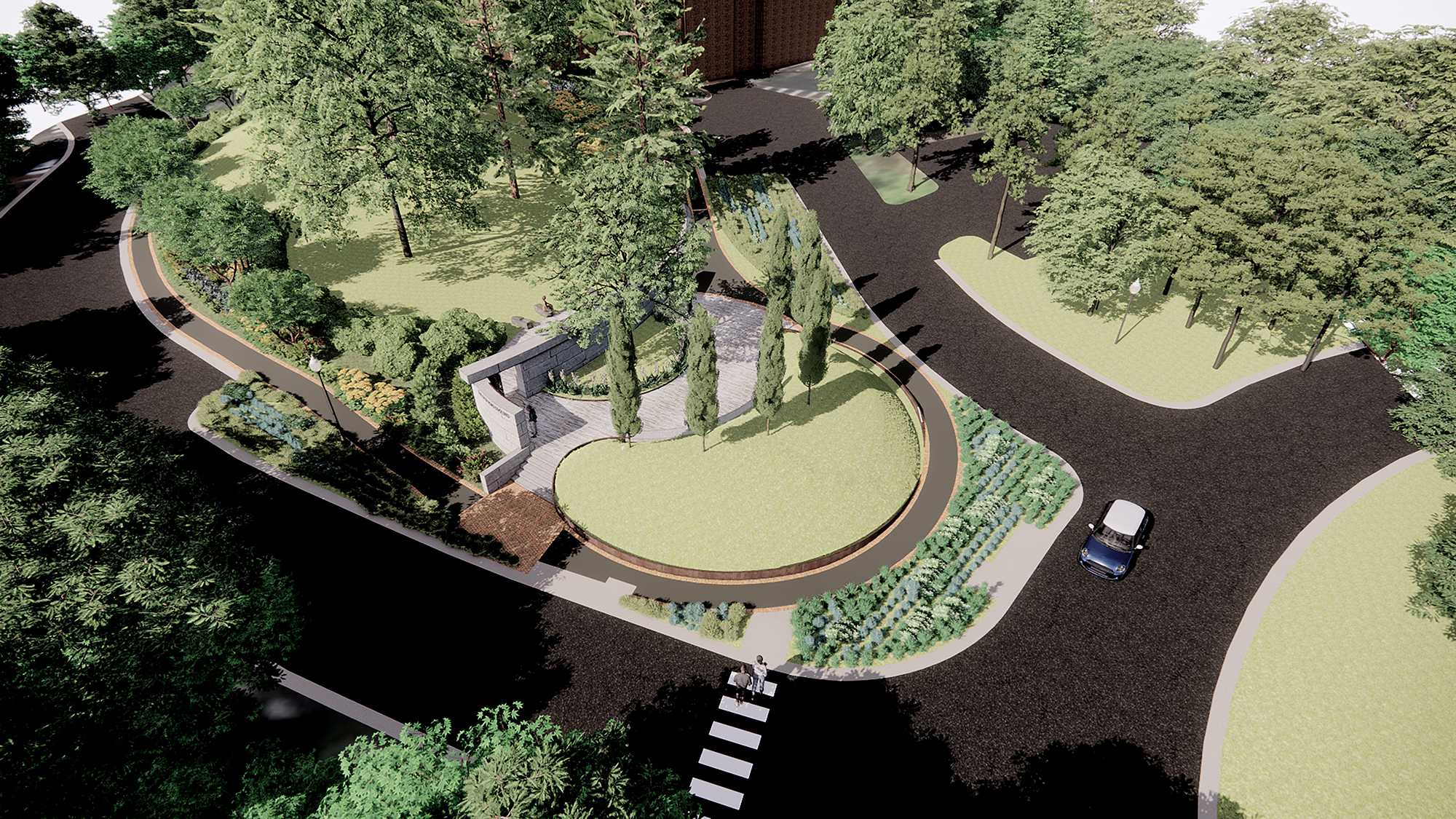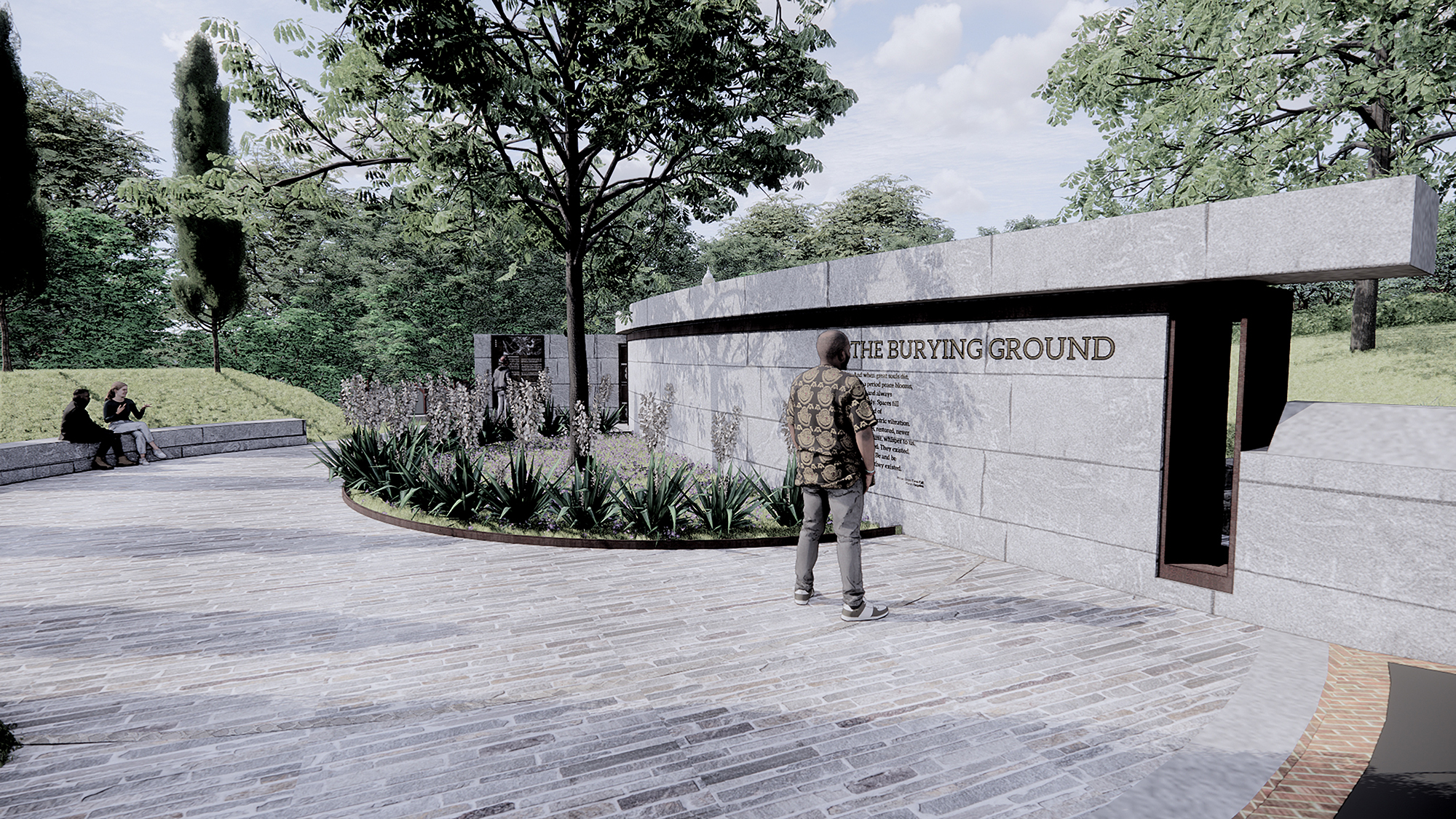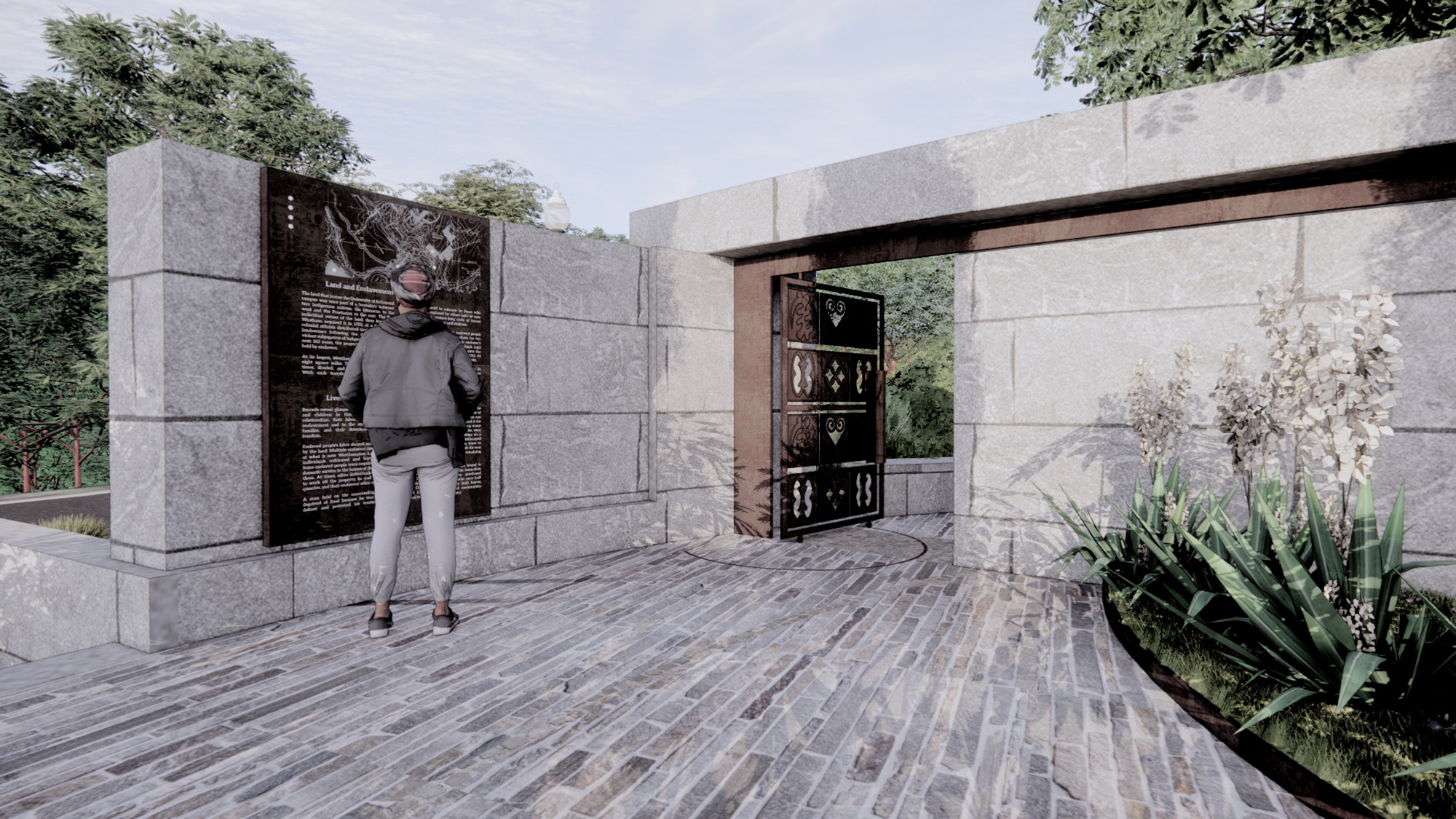
Burying Ground Memorial Updates
The University of Richmond is working toward a permanent memorial to honor those enslaved and laid to rest on the land that became this campus. A new website for the Burying Ground Memorial will be launched in April.
The plan for the memorial centers the design principles shaped by input from descendant and University communities during the work of the Burying Ground Memorialization Committee.
The Burying Ground site should remain sacred and lightly touched.
The Burying Ground should be unique, accessible, and inviting.
The Burying Ground should balance sentiments of reconciliation and resilience with the certainty of an enduring struggle.



Campus Messages
-
March 4, 2025: Burying Ground Memorial Update and Invitation
Dear Members of the University Community,
We are pleased to share that the Burying Ground Memorial project is progressing on schedule, and we expect the memorial to be complete and open to campus and visitors in late April. The permanent memorial honors the enslaved persons burying ground on a parcel of land that became our current campus in the early 20th century.
Since the Burying Ground Memorialization Committee completed its work in December 2021, the University retained Burt Pinnock with Baskervill architects to develop, evolve, and finalize a design. The University also partnered with Baskervill to commission archaeological site and Ground Penetrating Radar (GPR) surveys of the burying ground which supported minimizing ground disturbance and preserving the historical topography of the site. The final memorial design adheres to the design principles shaped by input from descendant and University communities during the work of the Memorialization Committee.
In the coming weeks, we invite you to:
- Attend the Burying Ground Memorial consecration on Wednesday, April 23, at 1 p.m. at the memorial site (near the intersection of Richmond Way and UR Drive). Please register here to join us and/or bring your class.
- Attend a Burying Ground Memorial info session on Thursday, April 24, at noon; Friday, April 25, at 2 p.m.; or Saturday, April 26, at 10 a.m. Please register here.
The research report on the history of the enslaved burying ground can be found here. Additional information about the memorial can be found at this website.
Sincerely,
David Hale
Executive Vice President and Chief Operating OfficerKeith McIntosh
Vice President for Information Services and Chief Information Officer, Co-Chair of the Burying Ground Memorialization CommitteeAmy Howard
Associate Provost, Strategic Initiatives and Community Engagement -
May 13, 2024: Burying Ground Memorial Update
Dear Members of the Campus Community,
Since our last message in March, the University of Richmond applied for and received a permit from the Virginia Department of Historic Resources (DHR) to excavate near the perimeter of the Burying Ground Memorial to carefully examine, remove, and rebury soil composition that was identified by an archaeologist as consistent with the presence of gravesites. After gaining approval from descendants on the process and receiving the permit from DHR, excavation work by two archeologists was completed last week in the area where the utilities were being rerouted. We are now able to confirm that after careful examination beneath the surface, the archeologists have determined that the identified features are not graves.
The decision to engage in consultation with the descendants, and later with the Richmond community, to obtain a burial permit was made based on the preliminary information in hand, including inconclusive GPR results for the area, and out of extreme caution to protect this sacred place. Moving forward, we will continue to have archaeology monitoring on-site during earthmoving activity as we uphold the Burying Ground design principles. Construction activity to create the memorial will resume this week.
The University will continue to work in partnership with the descendant community to preserve the integrity and sanctity of the burying ground site and to memorialize it.
Future updates will be available on the website.
David Hale
Executive Vice President and Chief Operating Officer
Keith McIntosh
Vice President for Information Services and Chief Information Officer
Amy Howard
Senior Administrative Officer for Equity and Community -
March 16, 2024: Burying Ground Memorial Update
Dear Members of the University Community,
As anticipated in our January message, work began this month on a permanent memorial to remember those enslaved on the land and interred in the burying ground site that became part of the University campus in 1910. Plans for the memorial were developed in partnership with the descendant community, the campus community, and the Burying Ground Memorialization Committee.
In creating the memorial, the University is committed to as little disturbance as possible of the site and to adhering to best practices, including having an archaeologist present for work that involves disturbing the ground. One of the first steps in the construction process is to discontinue existing utility lines that are currently within the memorial site and establish new lines along the site’s perimeter to avoid the need to access the original lines in the future.
The archaeologist monitors the site and informs the construction team and the University immediately if archaeological evidence of a burial is identified. During recent utility work along the site’s perimeter, the archaeologist identified soil composition and nails that appear consistent with the presence of gravesites within the site. The construction team, with the University, halted all earthmoving in the area of discovery and secured the area against further disturbance. The University has reached out to the descendant community to share this development and has also been in consultation with the Virginia Department of Historic Resources (DHR), which provides guidance and administers certain processes related to the preservation and protection of the state’s historic cemeteries and burial grounds.
After meeting with the University to discuss the findings, members of the descendant community have expressed their desire that the evidence of burial be reburied at the appropriate time within the Burying Ground Memorial site. The University has applied for the necessary permit through DHR which, if granted, would allow archaeological excavation, careful removal, and the respectful reburial within the Burying Ground Memorial.
We will continue to work in partnership with the descendant community to preserve the integrity and sanctity of the burying ground site.
Future updates will be available on the website.
David Hale
Executive Vice President and Chief Operating Officer
Keith McIntosh
Vice President for Information Services and Chief Information Officer
Amy Howard
Senior Administrative Officer for Equity and Community -
Jan. 16, 2024: Update on The Burying Ground Memorial
Dear Members of the University Community,
We are pleased to share that after several years of extensive work, the University’s Board of Trustees has approved the creation of a permanent memorial to honor the enslaved persons burying ground on a parcel of land that became our current campus. Construction for The Burying Ground Memorial at the University of Richmond is anticipated to begin in February and is expected to last for ten to twelve months. We are grateful for the ongoing interest, support, and input from descendant and campus stakeholders.
Since the Burying Ground Memorialization Committee completed its work in December of 2021, the University retained Burt Pinnock from Baskervill architects to develop, evolve, and finalize a design based on several years of listening and work. The University also partnered with Baskervill to commission archaeological site and Ground Penetrating Radar (GPR) surveys of the burying ground, which support minimizing ground disturbance and preserving the historical topography of the burying ground.
Centering the design principles shaped by input from descendant and University communities during the work of the Burying Ground Memorialization Committee, Mr. Pinnock and his team have worked creatively and thoughtfully on the design of this important memorial. In the coming weeks, we invite you to:
- Attend the MLK Celebration Committee’s Beloved Community Gathering on January 23 from 4–5 p.m. to celebrate this year’s “Commit to Humanity” theme, build community, and view images of The Burying Ground Memorial design.
- Attend a session with architect Burt Pinnock to view the finalized design on February 2 at 3:30 p.m. in Tyler Haynes Commons 305.
- Continue to learn more about the history of the enslaved burying ground that predates the campus.
Later this month, we will hold a private ceremony for descendants to mark this important milestone in the process and will update the website with additional information.
Sincerely,
David Hale
Executive Vice President and Chief Operating OfficerKeith McIntosh
Vice President for Information Services and Chief Information Officer, Co-Chair of the Burying Ground Memorialization CommitteeAmy Howard
Senior Administrative Officer for Equity and Community -
Jan.19, 2023: Burying Ground Memorial Update and Invitation
Dear Members of the University Community,
We write with an update on the extensive work associated with the University’s creation of a permanent memorial to honor the enslaved burying ground on the land that became the current campus. Since the Burying Ground Memorialization Committee completed its work, the University retained Burt Pinnock from Baskervill architects to finalize a design based on two years of listening and work. The University also partnered with Baskervill to commission an archaeological site survey of the burying ground to ensure the design would preserve the historical topography and minimize ground disturbance.
Centering the design principles shaped by input from descendant and University communities during the work of the Burying Ground Memorialization Committee, Mr. Pinnock and his team have worked creatively and carefully to evolve the design of this important memorial. We are eager for them to share the schematic design of the memorial with our campus and descendant communities. Please consider joining us for one session next month to learn more about the design and share your feedback. All are welcome.
Thursday, February 2, 4–5 p.m. Alice Haynes Room, Tyler Haynes Commons
Saturday, February 11, 2:30–3:30 p.m. Pilgrim Journey Church, 7204 Bethlehem Road, Henrico, Virginia
Tuesday, February 21, 7–8 p.m. via ZoomFor more information on the burying ground memorial, please visit the website.
Sincerely,
David Hale
Executive Vice President and Chief Operating Officer
Keith McIntosh
Vice President for Information Services and Chief Information Officer
Amy Howard
Senior Administrative Officer for Equity and Community -
Sept. 13, 2022: Site Work
Guided by the Burying Ground Memorialization Committee’s design principles, shaped by input from the University and descendants communities, the University has:
- Retained Baskervill architect Burt Pinnock, who served as design consultant to the Committee, to finalize a design based on two years of listening.
- Partnered with Baskervill to hire an archaeologist to complete site work to help preserve the historical topography and minimize ground disturbance as we work towards an enduring memorial. This is in addition to the ground-penetrating radar study of the area in 2019. Please note that this careful site work will start on Tuesday, September 13 and last a few days.
Baskervill will continue design work over the fall.
-
Feb. 3, 2022: Burying Ground Memorialization Committee Report
Dear Spider Community,
I am pleased to share with you the Burying Ground Memorialization Committee Final Report.
This excellent report builds on Ms. Shelby Driskill and Dr. Lauranett Lee’s important, university-supported research that documented the history of enslavement on the land that is now our campus and the names and stories of some who lived and labored on this land, the location of an enslaved burying ground here, and the University’s desecration of that burying ground during the 20th-century development of the campus. In response to this research, my predecessor, President Emeritus Ronald A. Crutcher, established the Burying Ground Memorialization Committee and charged it with engaging a range of stakeholders in discussions about memorializing the enslaved persons on this land before the University’s arrival here in 1914, and the burying ground specifically. I’m grateful to the Committee for fulfilling its charge. I encourage each of you to carefully read and reflect on this report.
Over the past two years, the Committee has carried out its work with humility and honesty, reverence and respect, and honor and care. I would like to thank the Committee co-chairs, President Emeritus Edward Ayers and Vice President and Chief Information Officer Keith McIntosh, and the entire Committee of student, staff, faculty, alumni, and Trustee members for so thoughtfully and inclusively engaging our campus and broader community in constructive dialogue about this important history. I’m also grateful to all the Committee’s advisors and consultants, including Henrico County public historian Mrs. Brenda Dabney Nichols, who spearheaded the Committee’s engagement with descendant communities. Finally, I’d like to thank everyone who shared their perspective on how to memorialize the burying ground.
Moving forward, we will consider the design concepts for a memorial included within the report, which were shaped by input from our university community and the descendant community. I endorse the Committee’s recommendation that the burying ground should remain “sacred and lightly touched,” with a memorial that honors those interred here and others enslaved on this land. To that end, we will conduct a comprehensive sitesurvey of the burying ground to help preserve the historical topography and minimize ground disturbance as we work towards an enduring memorial. This is in addition to the University’s 2019 ground-penetrating radar study of the area. We will also engage an architectural firm to refine and complete a final design and actualize the memorial, as we work toward creating an appropriate and reverent space. Work on these steps will begin this spring, with anticipated completion of the memorial in 2023. Finally, through our university’s Equity & Community team, we will continue to build our important relationship with the descendant community and support students, staff, faculty, alumni, and the wider regional community in learning about the history of the burying ground.
By engaging with this report and our ongoing efforts to memorialize the burying ground, each of us can contribute to the University’s efforts to more fully and inclusively examine our past, discuss our present, and shape our future. I hope you will join me in this important work, and I look forward to our continued collaboration.Kevin F. Hallock
President